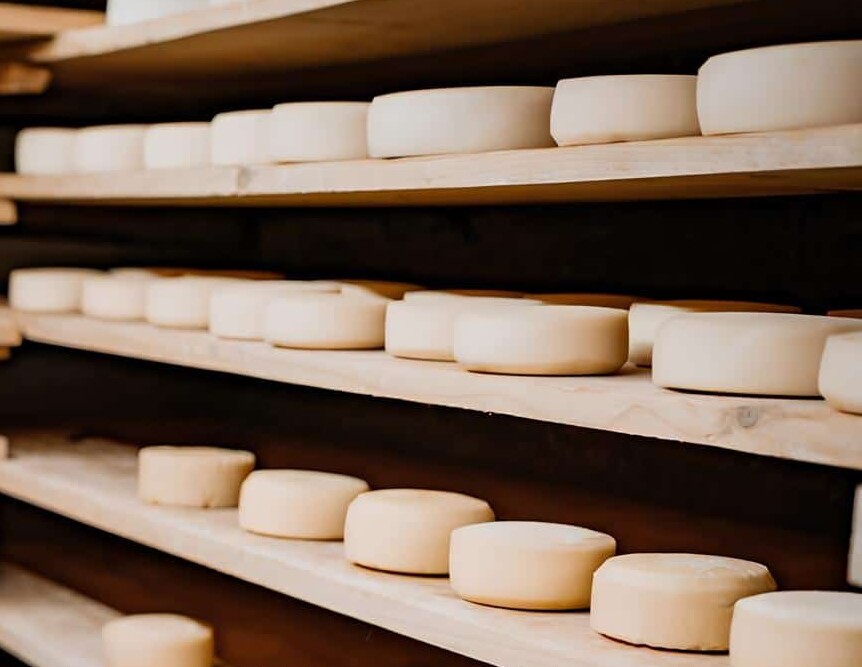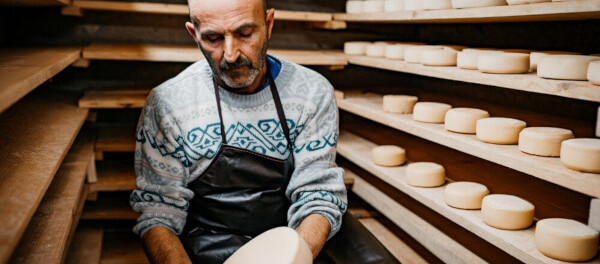Table of Content
- The Genetic Bottleneck: Understanding the Brie and Camembert Cheese Crisis
- The Role of Penicillium camemberti and Consequences for Manufacturers of Cheese
- Exploring Alternative Molds for Brie and Camembert Cheese
- Pro Tip: Geotrichum candidum Blends with Penicillium for Soft Cheese
- The Importance of Diversifying Sourcing for Brie and Camembert Cheese
- AOC Regulations and the Brie Crisis: Challenges for Manufacturers of Cheese
- Will "Neo-Brie" Replace the Real Thing? The Changing Soft Cheese Market
- Conclusion
1. The Genetic Bottleneck: Understanding the Brie and Camembert Cheese Crisis
A serious problem is putting the future of real French Brie and Camembert cheese at risk, causing major concerns in the food industry. For manufacturers of cheese, this isn’t just about losing a favorite product—it’s a warning about how fragile our food systems are and why we need to act now to reduce risks.
The issue comes down to the mold used to make these famous cheeses. For years, manufacturers of cheese, especially those using traditional French methods, have depended almost entirely on one type of mold called Penicillium camemberti.
This mold gives Brie and Camembert their white rind and creamy texture. It was chosen because it’s efficient and delivers consistent results in look and taste. But over time, the mold’s genetic diversity has shrunk dramatically.
Because the mold is so genetically similar, it can’t reproduce through mating, which is key for creating genetic diversity and keeping organisms strong and adaptable. Instead, it clones itself over and over, creating a uniform population that’s vulnerable to diseases, environmental changes, and other threats.
It’s like farming only one crop—if something goes wrong, the whole harvest is at risk. The same danger applies to the mold used for Brie and Camembert.
This isn’t just a theory—it’s already happening. Scientists have found that Penicillium camemberti is getting weaker and harder to grow, causing shortages and challenges for manufacturers of cheese, especially those using traditional methods.
What was once a reliable way to make consistent, high-quality cheese has turned into a major weakness. This problem doesn’t just affect Brie and Camembert cheese—it also threatens other cheeses that rely on specific molds, putting their long-term survival at risk.
As the cheese industry faces new challenges, suppliers have the opportunity to innovate while preserving tradition. Finding a reliable manufacturer of cheese who offers high-quality cheese cultures and fermentation products is essential for maintaining excellence and consistency. Explore europages’ cheese product listing dedicated to manufacturers of cheese.
2. The Role of Penicillium camemberti and Consequences for Manufacturers of Cheese
Penicillium camemberti is essential for making Brie and Camembert cheese. During the ripening process, it forms the iconic white rind and helps develop the cheeses’ signature flavor and creamy texture. The mold’s enzymes break down proteins and fats, creating the unique taste and texture that define these soft cheeses.
While other molds exist, they don’t deliver the same results. Some may produce a thicker rind or alter the flavor, making it difficult for manufacturers of cheese to find a replacement that matches the exact qualities of authentic Brie and Camembert cheese.
This genetic issue is a major concern—it’s not just about finding any mold, but one that can perfectly replicate these cheeses.
If Penicillium camemberti disappears, manufacturers of cheese face serious challenges:
- Production Challenges: The mold is becoming harder to grow, leading to supply shortages, delays, and higher costs.
- Quality Control: A weaker mold can cause inconsistencies in rind, texture, or flavor, damaging brand reputation.
- Increased Costs: Scarcity drives up mold prices, raising production costs that may be passed on to consumers.
- Loss of Identity: Without a suitable replacement, recipes might change, resulting in cheese that’s no longer true Brie or Camembert, potentially risking legal issues with AOC designations.
- Supply Chain Disruptions: Relying on a single, vulnerable mold creates risks—any shortage can disrupt the entire production process.
- Impact on Exports: France exported 70,000 tons of Brie in 2023. Losing mass-produced Brie and Camembert would disrupt the global cheese market.
These are significant business risks for manufacturers of cheese. Reliable ingredients are crucial for consistent products and strong brands. This crisis highlights the need to diversify supplies and invest in research to ensure long-term sustainability.
For more details on the domestication of Penicillium camemberti, check out this study on Science Direct.

3. Exploring Alternative Molds for Brie and Camembert Cheese
To reduce the risks of relying solely on Penicillium camemberti, scientists are exploring other molds, including different Penicillium strains and fungi like Geotrichum candidum.
These alternatives could provide genetic diversity and resilience while maintaining the flavor and texture of traditional Brie and Camembert cheese. Manufacturers of cheese are experimenting with blends to achieve similar results, though replicating the exact qualities remains a challenge.
Consumer acceptance is a major hurdle. Will people embrace Brie or Camembert cheese made with a different mold, even if the taste is similar? Clear communication and education will be key, with manufacturers of cheese highlighting benefits like sustainability to gain support.
Perception also plays a role. Brie and Camembert are iconic French cheeses with strong traditions, and changes might face resistance. However, if consumers understand that alternative molds are necessary to preserve these cheeses for the long term, they may be more open to them. Transparency from manufacturers of cheese will be essential.
Marketing can help by emphasizing sustainability to appeal to eco-conscious buyers or promoting unique flavors to attract adventurous eaters. In the future, the market could diversify, with some producers sticking to Penicillium camemberti and others experimenting with new molds, offering both traditional and innovative varieties.
4. Pro Tip: Geotrichum candidum Blends with Penicillium for Soft Cheese
Exploring the potential of Geotrichum candidum could offer a promising solution for manufacturers of cheese. While it doesn’t perfectly replicate the rind and flavor of Penicillium camemberti, it has notable strengths, including robustness and ease of cultivation. Additionally, Geotrichum candidum can be used alongside other Penicillium species—such as weakened P. camemberti or alternative strains—to support the ripening process.
This mold acts as a "helper," improving texture and flavor while creating a more diverse and resilient microbial ecosystem on the cheese. Researching blends and co-cultures that include Geotrichum candidum could help manufacturers of cheese reduce their reliance on a single, vulnerable mold like P. camemberti.
5. The Importance of Diversifying Sourcing for Brie and Camembert Cheese
This crisis highlights the need to diversify sourcing. Relying on a single supplier or ingredient, especially one at risk of disappearing, is too risky. Diversification means finding multiple suppliers for the same or similar ingredients.
For Brie and Camembert cheese, this could involve working with manufacturers of cheese using alternative molds or exploring cheeses from other regions that don’t depend on Penicillium camemberti.
The benefits include:
- Reduced Risk: If one supplier has issues, others can step in.
- Increased Flexibility: Businesses can adapt more easily to market changes.
- Better Bargaining Power: Multiple suppliers improve negotiating leverage.
- More Innovation: Collaborating with different suppliers can spark new ideas.
Diversification takes planning and research. Manufacturers of cheese need to identify potential suppliers, evaluate their capabilities, and build strong relationships. While it requires effort, the long-term benefits are significant.
This issue isn’t just a French problem—it affects the global market. Brie and Camembert cheese are popular worldwide, so a supply disruption would have far-reaching effects. Importing countries would face shortages and higher prices, while retailers and restaurants would struggle to meet demand.
However, this crisis could also create opportunities for manufacturers of cheese in other countries. If French producers can’t keep up, others might fill the gap, boosting competition and innovation in the soft cheese market.
Still, replicating the unique qualities of Brie and Camembert isn’t easy. France’s terroir—its climate, soil, and microbial environment—plays a key role. While other countries might produce similar cheeses, they may not fully match the authentic French product.
This situation shows the complexity of the global cheese market and why manufacturers of cheese must address vulnerabilities in their supply chains.
Are you looking for a manufacturer of cheese with a resilient and diversified supply chain? Request a quote on our website to find the ideal supplier. Manufacturers of cheese like Sélectarôme and Pâturages Comptois understand the importance of consistent quality and reliable sourcing, and we can connect you with partners who share those values.

6. AOC Regulations and the Brie Crisis: Challenges for Manufacturers of Cheese
The Brie and Camembert crisis also highlights the challenges posed by food regulations and protected designations of origin, such as France’s Appellation d’Origine Contrôlée (AOC) system.
Soft cheeses like Brie de Meaux, Brie de Melun, and Camembert de Normandie are protected under AOC, meaning they must be produced in specific regions using traditional methods—including the use of Penicillium camemberti. This system safeguards the heritage, quality, and authenticity of these cheeses but creates limitations, especially during crises.
If Penicillium camemberti becomes unavailable or too difficult to use, manufacturers of cheese face tough choices:
- Continue using it: They could stick with Penicillium camemberti, even if it means higher costs, reduced production, or inconsistent quality. This would preserve the AOC designation but could threaten their business viability.
- Switch to an alternative mold: Using a different mold might mean losing the right to label their product as Brie de Meaux, Brie de Melun, or Camembert de Normandie. This could hurt brand recognition, market position, and pricing power.
- Seek a new AOC designation: Manufacturers of cheese could explore creating a new AOC designation for cheeses made with alternative molds. However, this would require extensive scientific evidence, sensory evaluations, and negotiations with regulators—a complex and uncertain process.
For businesses sourcing these cheeses, this regulatory uncertainty adds another layer of complexity. Contracts may need to be reviewed, labeling and marketing materials updated, and there’s a risk of consumer confusion or legal challenges.
This crisis not only threatens the production of these iconic French cheeses but also raises questions about how to balance tradition, innovation, and market demands in a changing world.
7. Will "Neo-Brie" Replace the Real Thing? The Changing Soft Cheese Market
Regardless of how AOC regulatory issues are resolved, the Penicillium camemberti crisis is likely to accelerate changes in the soft cheese market. This could lead to the rise of what might be called "Neo-Brie" and "Camembert-Style" cheeses—products made with alternative molds, possibly outside traditional regions, and marketed under new names that don’t conflict with AOC rules.
This shift brings both opportunities and challenges for manufacturers of cheese:
Opportunities:
- Innovation and Differentiation: Without AOC restrictions, producers can experiment with new molds, techniques, and flavors, creating a wider variety of soft, bloomy-rind cheeses.
- Sustainability: Using more resilient molds can be marketed as a greener, more sustainable approach to cheese production.
- New Markets: "Neo-Brie" and "Camembert-Style" cheeses could attract adventurous consumers or those seeking sustainable, locally made options.
- Lower Costs: Producing cheeses outside AOC guidelines may reduce production costs.
Challenges:
- Consumer Acceptance: Shifting the belief that "Brie" and "Camembert" require Penicillium camemberti will be tough. In France, cheese is a national treasure, with a mindset akin to wine—only French versions are seen as authentic. Will consumers reject new variations? Education and marketing will be crucial to changing this perception.
- Branding and Positioning: New brand names and strategies will be needed to stand out while still highlighting the cheeses’ appealing qualities.
- Competition: The "Neo-Brie" market could become crowded, with both established producers and newcomers competing for attention.
- Quality Control: Ensuring consistent quality and food safety will be critical for these new products.
For B2B buyers and manufacturers of cheese, this shift means more options but also more work. They’ll need to carefully evaluate these new cheeses, understanding the molds used, production methods, and flavor profiles.
The market may become more fragmented, requiring buyers to build relationships with a wider range of suppliers. This change sets the stage for the need to adapt and stay informed in an evolving market.
Are you a manufacturer of cheese seeking to expand your reach and showcase your products to a wider B2B audience? Request a consultation with our team to explore partnership opportunities.

8. Conclusion
The potential crisis facing traditional French Brie and Camembert cheese, caused by the genetic vulnerability of Penicillium camemberti, offers important lessons for the B2B food industry and manufacturers of cheese.
It highlights the risks of relying on monocultures, whether in farming or microbial processes, and underscores the need for proactive risk management through diversifying sourcing and investing in research and development.
At the same time, it reveals the tension between tradition—such as AOC designations—and the growing need for innovation in a changing world. Manufacturers of cheese are now rethinking long-standing practices, potentially leading to a more diverse and resilient soft cheese market with products like "Neo-Brie" and "Camembert-style" cheeses.
Beyond Brie and Camembert, this crisis raises broader questions about microbial diversity in food production. Many fermented foods—like sourdough bread, kimchi, and certain sausages—depend on specific microbial cultures. Are these cultures also at risk due to genetic bottlenecks? Are we doing enough to monitor and protect the microbial biodiversity that supports our food system?
The "Brie crisis" should act as a wake-up call, encouraging a closer look at the genetic health of the microorganisms we rely on and a more proactive approach to preserving their diversity. This is essential for ensuring the long-term sustainability of our food supply.
For more information about the food industry and current trends, read these insightful articles:

